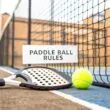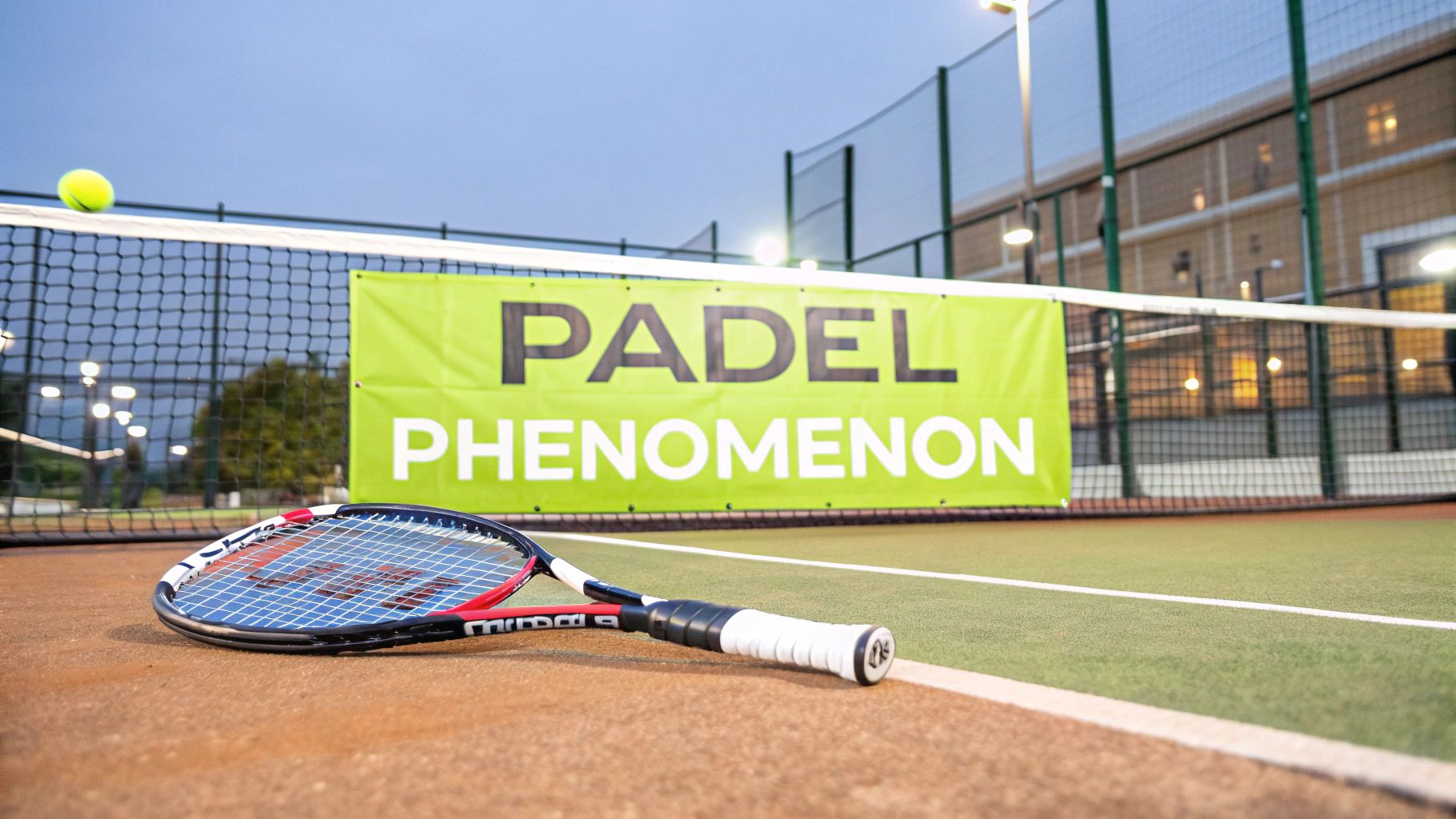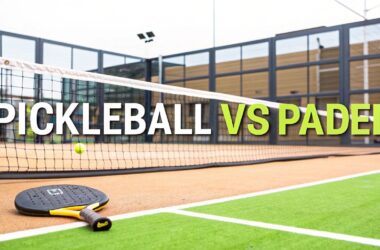Ever wondered about those glass-walled courts popping up everywhere? You're witnessing the rise of the padel sport, a game that brilliantly fuses the best parts of tennis and squash. It’s a social, incredibly fun racket sport that's surprisingly easy to get the hang of, which explains why millions have fallen for it.
The Global Padel Sport Phenomenon
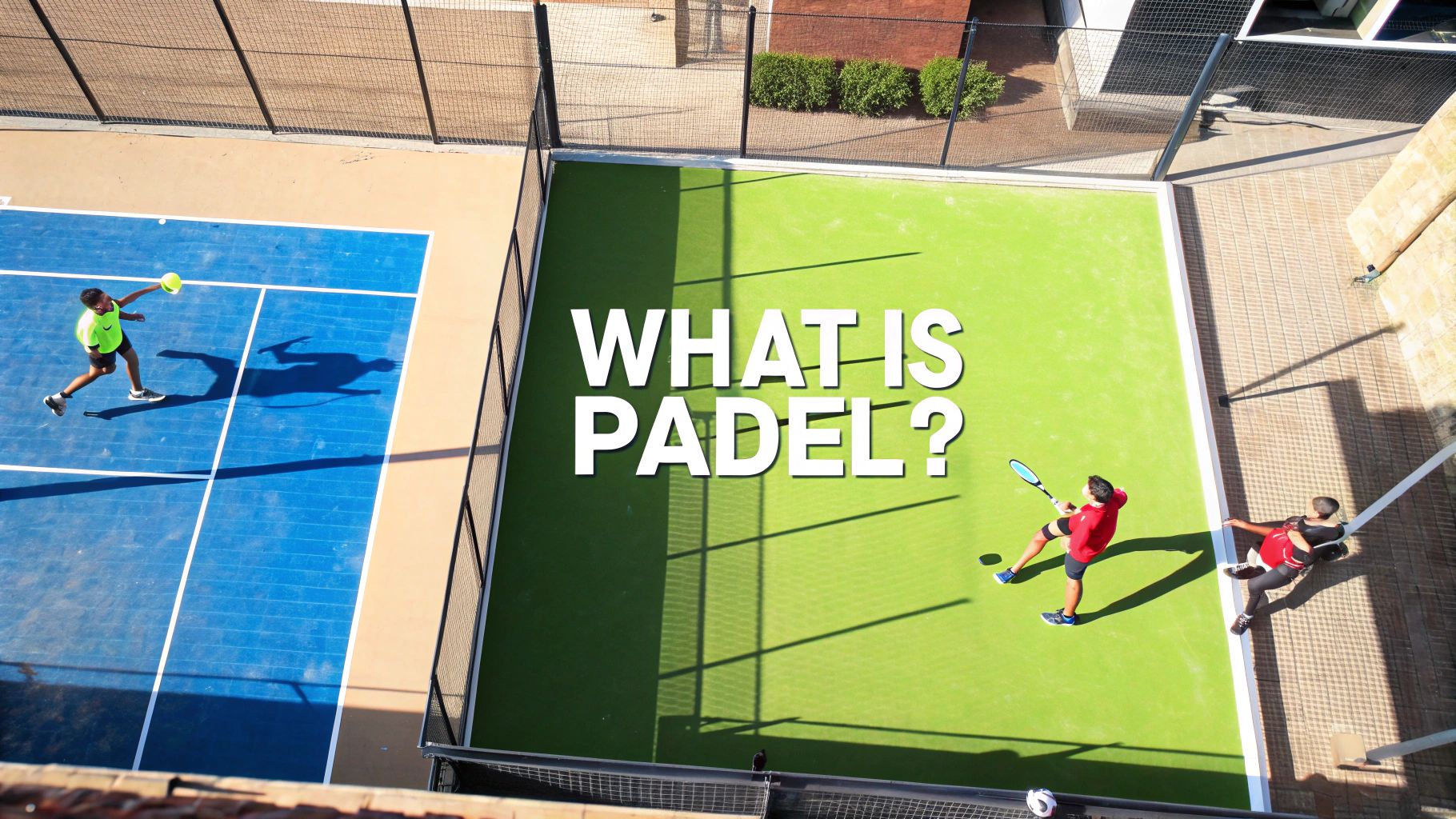
Padel is way more than just a passing trend; it's a genuine global movement. Think about combining the thrilling, fast-paced rallies of tennis with the strategic, wall-bouncing shots of squash. Now, imagine that game on a smaller, enclosed court, always played in doubles. That's padel—a high-energy sport where teamwork and quick wits often trump raw power.
This unique blend is what makes the padel sport so welcoming for beginners. Forget spending months trying to master a tricky overhead serve like in tennis. The underhand serve in padel gets you into a rally almost instantly, making your first time on the court a blast. This low barrier to entry is a huge reason for its explosive growth.

Buy the best padel gear to level up your next game!
CHECK OUT this deal from Padel Market!Get ready to take your game to the next level with the latest padel gear from Padel Market! Fast EU and Worldwide Shipping
To give you a quick snapshot of what makes this sport tick, here's a simple breakdown.
Padel Sport at a Glance
| Characteristic | Description |
|---|---|
| Players | Always played in doubles (2 vs. 2). |
| Court | A 10m x 20m court enclosed by glass and mesh walls. |
| Scoring | Same scoring system as tennis (15, 30, 40, Deuce, Game). |
| Serve | Must be underhand, with the ball bouncing once before contact. |
| Gameplay | The ball can be played off the walls after bouncing once on the court. |
| Social Aspect | High, due to the doubles format and close proximity of players. |
This table shows just how these elements combine to create a game that's both easy to start and endlessly engaging.
An Unstoppable Rise in Popularity
The sport's growth isn't just a feeling; the numbers are staggering. Padel has absolutely surged over the last decade, becoming one of the fastest-growing sports on the planet. Back in 2014, the World Padel Tour estimated there were about 12 million players. Fast forward to 2024, and that number has exploded to roughly 30 million players—more than doubling in just ten years.
The sport is also reaching more corners of the globe, growing from around 90 countries in 2021 to at least 130 by 2024. If you want to dive deeper into its core concepts, you can learn more about what padel is and its foundational elements.
What’s really cool is how balanced the participation is. Roughly 40% of all players are women, a remarkably high figure for a racket sport that shows just how broad its appeal is.
Padel's magic really lies in its social core. It’s almost always played in doubles, turning every match into a fun, social outing where communication and teamwork are just as crucial as hitting a perfect shot.
Why Padel Appeals to Everyone
One of the biggest reasons for the padel sport's success is how inclusive it is. It's a game that brings together different generations and fitness levels, letting families and friends with varying athletic skills share a court for a fun, competitive match.
Here’s a quick look at what makes it so addictive:
- Low Physical Demands: The court is smaller, so there's less running around. This makes it much easier on the joints compared to tennis.
- Simple to Learn: With an underhand serve and intuitive rules, you can start having fun from your very first game.
- Highly Social: The doubles format and close quarters mean you're constantly chatting and working with your partner.
- Strategic Depth: It's easy to learn, but hard to master. Advanced players find endless challenges in learning to use the walls and developing clever tactics.
The Unlikely Origins of Padel
Every great sport has an origin story, and padel's tale is a fascinating one. It doesn't begin on a grand, competitive stage, but in the sun-drenched backyard of a businessman in Acapulco, Mexico. The year was 1969, and Enrique Corcuera had a problem: he wanted a squash court but simply didn't have the room.
Instead of giving up, he got creative. Corcuera built a court that was smaller than a standard tennis court—about 10 by 20 meters—and enclosed it with walls and wire mesh. This wasn't just to stop the ball from flying into his neighbor's garden; it was a move that accidentally created the defining feature of a brand-new game. Armed with simple, stringless wooden paddles, he and his guests started playing a game that was less about brute force and more about clever shots and strategy.
What started as a fun little game for Corcuera's friends and family was about to go global, all thanks to one very influential guest.
From a Private Estate to European Royalty
One of Corcuera's regular visitors was his friend, Prince Alfonso de Hohenlohe, a Spanish aristocrat with a taste for new ventures. The Prince was instantly captivated by the game during his trips to Mexico and saw its massive potential. He decided this was something he had to bring back to Spain, but he planned to add a few refinements of his own.
In 1974, he did just that, building the first two official padel courts in Europe at his glamorous Marbella Club Hotel. These weren't just courts for a quick hit; they became a social hub for the jet-setters, celebrities, and aristocrats who flocked to the resort.
The sport's arrival at the Marbella Club was its big break. By charming Europe's elite, padel quickly gained an aura of exclusivity and cool that kickstarted its journey across the continent.
This early connection to luxury gave the sport a prestigious reputation right from the start.
The Spanish and Argentinian Strongholds
From the high-end setting of Marbella, it wasn't long before the padel sport started capturing the attention of everyday people. Spanish locals and tourists who saw the game being played were drawn to its fun, social vibe and how easy it was to pick up. Soon enough, padel clubs began sprouting up all over Spain, and the game transformed from an elite pastime into a full-blown national obsession.

Buy the best padel gear to level up your next game!
CHECK OUT this deal from Padel Market!Get ready to take your game to the next level with the latest padel gear from Padel Market! Fast EU and Worldwide Shipping
At the same time, the sport was exploding in another part of the world: Argentina. Friends of Prince Hohenlohe from Argentina had also fallen in love with the game and introduced it back home, where it became incredibly popular. For decades, Spain and Argentina were the undisputed heartlands of padel, developing the first professional leagues and producing generations of the world's top players. These two countries built the powerful foundation that has supported padel's recent and incredible global expansion.
Decoding the Padel Court and Equipment
To really get a feel for padel, you first have to understand the unique arena it’s played in and the specialized gear you’ll be using. This isn't your typical racket sport. Both the court and the equipment are specifically designed to make the game fast, strategic, and surprisingly easy for newcomers to pick up.
When you step onto a padel court for the first time, it feels like a mashup of tennis and squash. It's this unique, enclosed environment that makes the game so dynamic and social. The court is a compact rectangle, just 10 meters wide by 20 meters long, which is a lot smaller than a standard tennis court.
This cozy setup is surrounded by a mix of glass and metallic mesh walls. The back walls are usually tempered glass, while the sides are a combination of glass and mesh. But here’s the cool part: these walls aren't just boundaries. They’re part of the game. Just like in squash, you can play the ball off the walls, opening up a whole new world of angles and creative shots to outsmart your opponents.
The Heart of the Game: The Padel Court
The sport's popularity is absolutely exploding, and the infrastructure is racing to keep up. Back in 2022, there were about 40,000 padel courts worldwide. Fast forward to 2024, and that number has shot up to an estimated 63,000 courts spread across roughly 20,000 clubs, serving a massive global player base of 30 million.
If you're curious about this incredible growth, you can read more about the padel market's expansion on Padel Alto. This boom means it's easier than ever for new players to find a court and jump into the action.
Think of the padel court as a strategic box. Learning to use the corners and wall rebounds is like a billiards player learning to use the cushions—it transforms the game from a simple back-and-forth rally into a three-dimensional chess match.
Getting the court layout is half the battle; your equipment is the other half. The right gear can make all the difference, especially when you're just starting out.
Here's a quick look at the essential gear you'll need to get on the court.
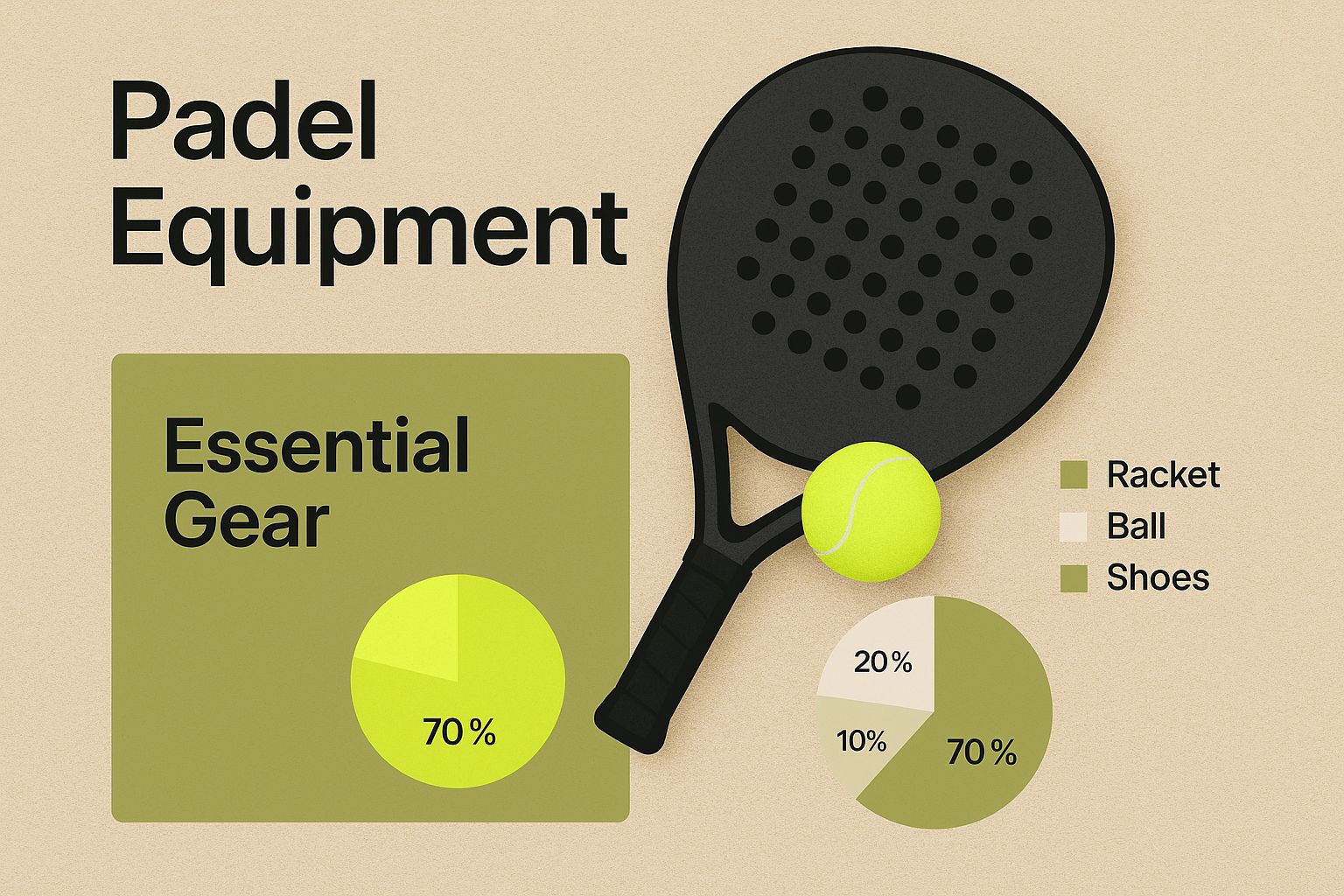
As you can see, the core tools are pretty straightforward: a modern, solid racket, a specific type of ball, and the right shoes for the surface.
Choosing Your Padel Racket
The first thing you'll notice about a padel racket, or “pala” as it's called, is that it has no strings. It's a solid, perforated paddle made of materials like foam, carbon fiber, or fiberglass. This design gives you fantastic control and makes it much easier to connect with the ball, which is a huge confidence booster for beginners.
Padel rackets come in three main shapes, and each one is suited for a different style of play.
Padel Racket Shape Comparison for Beginners
Choosing your first racket can feel a bit overwhelming, but understanding the three basic shapes makes it much simpler. This table breaks down what each shape offers, helping you find the perfect match for your game as you get started.
| Racket Shape | Primary Benefit | Best For |
|---|---|---|
| Round | Control | Beginners who need a forgiving racket with a large, central sweet spot. |
| Teardrop | Balance | Intermediate players wanting a mix of power and control. |
| Diamond | Power | Advanced players with precise technique looking for maximum shot strength. |
For most people just starting out, a round racket is the way to go. It’s the most forgiving and will help you build a solid foundation of control before you start chasing more power.
Other Essential Gear
Besides the racket, a couple of other items are non-negotiable for a good game of padel.
- Padel Balls: They might look just like tennis balls, but they have a lower internal pressure. This makes them a bit less bouncy, which slows the game down just enough to allow for longer rallies and more control on the smaller court.
- Proper Footwear: You'll be making a lot of quick, sharp movements in every direction, so the right shoes are vital. Padel-specific or clay-court tennis shoes with a herringbone sole give you the best grip on the artificial turf and help prevent injuries.
Starting with the right equipment not only keeps you safe but makes your introduction to the fantastic world of padel so much more fun.
Understanding the Rules and Scoring
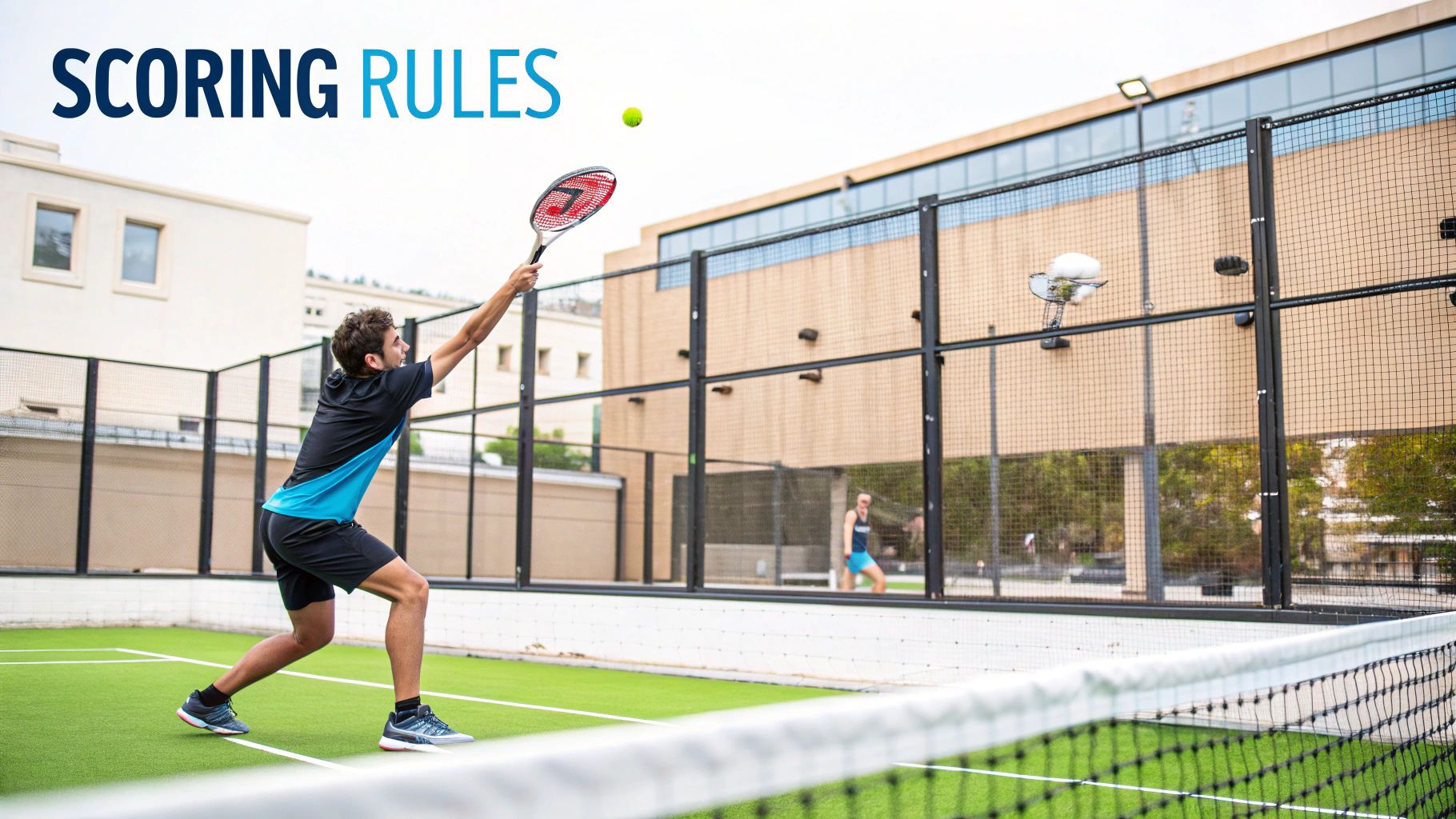
Padel's rules manage to feel both familiar and refreshingly new, which is a huge part of why it's one of the easiest racket sports to pick up. This simplicity isn't an accident—it's designed to get you into fun, flowing rallies almost right away. Getting a handle on these fundamentals is your ticket to stepping onto the court with confidence and actually enjoying your first game.
The best place to begin is with the serve. Forget the powerful, overhead serves that dominate tennis. In the padel sport, every serve is hit underhand. This one change makes a world of difference, making serves much easier to both hit and return, which means longer and more engaging points from the very start.
The Serve Made Simple
The serve is straightforward, but there are a few key rules you have to follow. It's really the only moment in the game where you have total control, so learning to do it well gives you a nice little advantage.
- Start Behind the Line: Both of your feet have to be behind the service line when you begin.
- Bounce the Ball: You have to bounce the ball once on the ground inside your service box before you hit it. The bounce must also happen behind the service line.
- Underhand Contact: You must hit the ball at or below your waist level. This is a non-negotiable rule and the defining feature of a padel serve.
- Serve Diagonally: The serve needs to fly diagonally over the net and land in your opponent's opposite service box. If it clips the net and then lands in the right box, it's called a "let," and you just replay the serve.
That underhand motion cuts down on the physical strain and technical skill needed, making the padel sport far less intimidating for newcomers.
The Flow of a Rally
Once the serve is in, the real fun begins. The rally is where padel's unique personality shines through, mainly because the walls become a part of the game. After the ball bounces once on your side, you can let it rebound off the back or side walls before you hit it back.
Think of the walls as your ally, not an obstacle. Using them smartly can flip a defensive scramble into an attacking play, helping you create wild angles and keep your opponents guessing.
You lose the point if the ball bounces more than once on your side, if you smack it into the net, or if you hit it directly into a wall or the fence on the other side without it bouncing on their court first. To get into the nitty-gritty, you can check out the complete rules of padel for a full breakdown of every possible scenario.
Keeping Score Like a Pro
Good news! If you've ever played or even just watched tennis, you already know how to keep score in padel. The scoring system is identical, which takes one more thing off a beginner's plate and lets you focus completely on playing.
Here’s a quick rundown of how the points go in a game:
- First point: 15
- Second point: 30
- Third point: 40
- Fourth point: Game
If the score gets tied at 40-40, it's called "Deuce." To win the game from there, a team has to win two points in a row. The first point after Deuce is called "Advantage," and the next point wins the game. This familiar scoring makes it easy to follow along, even in a tense match. A set is won by the first team to win six games by at least a two-game margin, and matches are usually the best of three sets.
Mastering the Essential Shots and Techniques
Alright, you know the rules and the layout of the court. Now it's time for the fun part: hitting the ball. Moving from theory to action is what turns you from a fan into a player, and the beautiful thing about padel is how quickly you can pick up the basics.
We'll start with the shots you might already recognize—the forehand and backhand—before getting into the techniques that make padel, well, padel. Think of the bandeja and, of course, using those glass walls. The goal here isn't just to teach you how to return the ball, but to get you thinking strategically from your very first match.
Building Your Foundation: The Forehand and Backhand
Just like in tennis, your groundstrokes are the bread and butter of your game. For beginners, the best way to start is with the Continental grip, which many people call the "hammer grip." It's simple: hold the racket like you're about to hammer a nail. This one grip works for almost everything—forehands, backhands, and volleys—so you don't have to overthink things.
Your stance is just as crucial. For a forehand, turn sideways to the net with your non-hitting shoulder pointing forward. As the ball comes, step into the shot with your opposite foot and try to make contact out in front of your body. The backhand is the same idea, just on the other side. If you're new to racket sports, a two-handed backhand can give you a lot more stability and power.
Think of your groundstrokes as your conversational tools in a rally. A solid forehand and backhand allow you to keep the "conversation" going, setting you up for more advanced and strategic shots later in the point.
Focus on consistency, not power. The court is small and the walls keep the ball in play, which means a well-placed, controlled shot is almost always better than trying to blast a winner past your opponents.
Padel’s Signature Moves: The Bandeja and Vibora
Once you've got your groundstrokes down, you'll quickly run into a classic padel situation: the lob. Your opponents will try to hit the ball high over your head to force you away from the net. Your instinct might be to let it bounce off the back wall, but a much better option is to master the defensive overhead shots that are unique to the padel sport.
The most important of these is the bandeja (Spanish for "tray"). This isn't a powerful smash; it's a controlled, defensive slice you hit while moving backward. The whole point is to keep the ball low after it bounces on the other side, stopping your opponents from launching an attack.
- The Bandeja: Imagine you're carrying a tray of drinks. You hit the ball with an open racket face, cutting under it to create backspin. This shot is your absolute best friend for holding your position at the net.
- The Vibora: The vibora (or "viper") is the bandeja's more aggressive cousin. You hit it with more side-spin and pace, aiming for it to "bite" off the court and shoot toward the side wall, making it a nightmare to return.
Get comfortable with the bandeja first. It's the defensive workhorse that will keep you in the point and prevent your opponents from taking over the net.
Making Friends with the Glass
This is it. The biggest mental hurdle for new players is learning to use the glass walls. It feels completely wrong at first, but playing the ball after it hits the back glass is a fundamental skill you have to learn.
When an opponent hits a deep shot, don't panic and try to hit it before it reaches the wall. Instead, let it go past you.
Turn and face the back wall, let the ball rebound, and then play your shot as it comes back toward the net. This one simple change gives you so much more time and space to set up a controlled return. You turn a tough defensive moment into a neutral or even offensive play. It takes patience and a bit of trust, but it’s a total game-changer. Once you get the hang of the back-wall rebound, the entire strategic depth of the padel sport will open up to you.
The Business and Future of Padel
Padel's explosive growth isn't just a story about a fun new sport—it's about a powerful economic engine that's turning heads. We're seeing serious attention from investors, major brands, and entrepreneurs from all over the world. This is way more than just a game; it's a thriving global industry whose financial growth is just as fast-paced as the on-court action.
An entire ecosystem has sprung up around padel, creating opportunities at every level. From specialized rackets and apparel to the red-hot business of court construction, a whole new market has put down firm roots.
And the numbers back it up. The global padel market was valued at a cool $327 million back in 2022, and it's projected to grow at an annual clip of 7.2% to 9.6%. The equipment segment alone is on track to be worth around $228.7 million by 2025. This isn't just a trend; it's a commercial powerhouse.
The Investment Boom
This kind of momentum doesn't go unnoticed for long. Big money is pouring into every corner of the padel universe. Private equity firms, celebrity investors, and huge corporations are all jumping in to fund new club developments, sponsor pro players, and back the major professional tours. As a result, these tours are getting bigger, pulling in larger audiences and landing more lucrative media deals.
This flood of capital is professionalizing the sport at a breakneck pace. To get a sense of where padel's business side could be headed, it's useful to look at how other established sports are run. The scale of major sports club operations offers a great blueprint for the kind of infrastructure and business models padel might adopt as it continues its global takeover.
A Bright and Expanding Future
So, what’s next? Honestly, the future of the padel sport looks incredibly bright. Its accessible, social nature makes it a sustainable product, not just a passing fad. We're already seeing new career paths open up for a generation of coaches, club managers, and event organizers. As more countries get hooked on padel, the demand for top-notch facilities and expertise is only going to climb.
The sustained investment and commercial interest are clear signals that padel is here to stay. It's building a solid foundation as both a beloved hobby and a serious professional sport with a global footprint.
On top of that, the professional circuits are consolidating and expanding their reach, which creates a more cohesive and thrilling story for fans to follow. If you want to keep up with the latest pro-level drama, you can stay updated on the professional padel world tour and see exactly how these investments are shaping the competitive scene. This professional growth then trickles down, sparking more interest at the grassroots level—a perfect, self-sustaining cycle that will keep padel's momentum going for years.
Common Questions About the Padel Sport
As you get closer to finally stepping onto a padel court, you probably have a few last-minute questions buzzing around. The padel sport is pretty unique, and it’s totally normal to wonder how it compares to other racquet sports you might already know. This section tackles the most common questions from newcomers, giving you clear, straight-to-the-point answers to feel confident for your first match.
Our goal here is to clear up any lingering confusion and give you that final nudge of encouragement to grab a racket and see what all the fuss is about.
What Is the Main Difference Between Padel and Tennis?
Even though they use the same scoring system, padel and tennis are worlds apart in practice. Three things really set them apart. First, the court. A padel court is smaller and fully enclosed by glass and mesh walls, which are very much in play. Think of it like squash meets tennis. Second is the racket; padel uses a solid, stringless paddle that gives you a ton of control.
Finally, and this is a big one, the serve in padel is always hit underhand after bouncing it once. This single rule change makes the serve much easier to learn and return, which means you get longer, more exciting rallies right from your very first game.
Is Padel Physically Demanding?
One of padel's best features is how accessible it is. It's generally less physically taxing than a full-on game of tennis or squash, making it perfect for a huge range of ages and fitness levels. The smaller court means less all-out sprinting, and the gentle underhand serve saves a lot of wear and tear on your shoulder and back.
But don’t mistake "accessible" for "easy." At a competitive level, the padel sport becomes a seriously fast-paced, athletic workout demanding incredible reflexes, agility, and strategic thinking. It's a game where you can truly dial the intensity up or down to whatever suits you.
Padel’s genius lies in its scalability. It can be a relaxed, social hit-around with friends or a high-octane, physically demanding contest. The game meets you where you are, making it enjoyable for nearly everyone.
Do I Need a Partner to Start Playing Padel?
Yes, padel is almost always played as doubles, so you'll need three other people for a proper match. This is a huge part of what makes the sport so social and focused on teamwork. But don't let that stop you if you don't have a crew ready to go.
Plenty of new players are in the same boat. Most clubs and community apps have "matchmaking" features or open-play sessions. You can just sign up for a game and get paired with other players at your skill level. It's actually a fantastic way to meet new people and find future padel partners.
Can I Use Tennis Balls to Play Padel?
While they look nearly identical, you really shouldn't use tennis balls for padel. It might seem like a small detail, but padel balls are made with slightly lower internal pressure, which makes them less bouncy. This difference is critical to the game's feel.
That lower bounce is specifically designed for the smaller, enclosed court. It gives you more time to react and much better control over your shots, especially when you start playing tricky rebounds off the glass walls. Using proper padel balls from the start ensures you learn the game the way it's meant to be played.
At Padel Rumors, we are dedicated to helping you navigate every aspect of this incredible sport. Whether you're a beginner looking for guides or a seasoned player tracking the latest news, find everything you need to fuel your passion at https://www.padelrumors.com.


